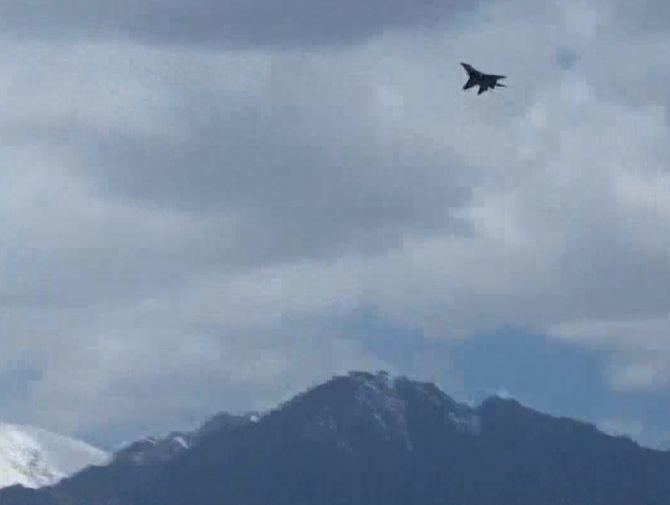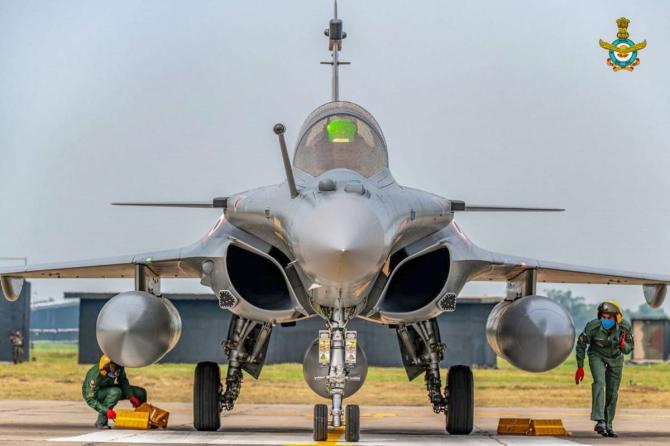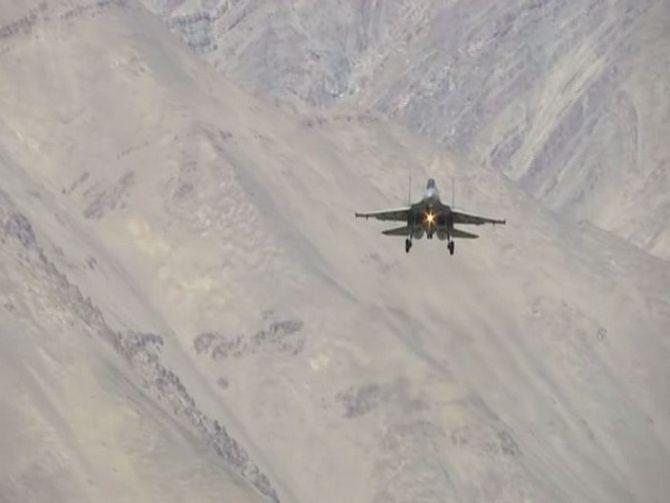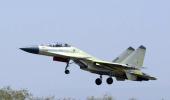'Our air force can strike them with impunity.'

Air Marshal Raghunath Nambiar (retd) PVSM, AVSM, VM & bar, ADC retired as the Air Officer Commanding of the prestigious Western Air Command in October 2019.
The air marshal has also commanded the Eastern Air Command based at Shillong and flown 42 different types of aircraft in his 38-year career in the Indian Air Force.
"We need a change in focus in war -- of fighting with China and need to prepare for the same soonest!", Air Marshal Nambiar tells Air Commodore Nitin Sathe (retd).

How will the Rafale change the dynamics of future conflicts?
How does it compare with the Chinese fighters of the J-20 class?
In your view, should we go in for more of these aircraft or do with the less costly MiG-29 upgrade and the SU30 class of aircraft from Russia?
Yes, the Rafale definitely changes dynamics for future wars.
You see, in Kargil, we were the only ones who had real long range beyond visual range missiles to thwart the Air to Air threat.
Therefore, we had the advantage and could fly around with impunity as the F-16s of the Pakistanis and their missiles were no match to ours.
In the interim, Pakistan acquired the AMRAAM (AIM 120-C) missiles which had longer reach than ours.
Therefore, the advantage shifted to the other side for a while.
It is like fighting a man with a spear holding a dagger.
The dagger can only get the spear out when it is pointing the other way-and that isn't easy.
We have set it right with the acquisition of the Meteor missile on the Rafale and the advantage shifts back to us with the Rafale.
It is more sophisticated, has more stealth and therefore the balance of power will shift back to us now.
The Pakistanis cannot attempt a mission like the one they did on February 27 last year anymore-unless they are foolish enough to accept losses.
Rafale, therefore, brings in a far better capability and is far more potent than even the J-20 class of the Chinese aircraft which I will talk about now.
In my opinion, the J-20 is 'all show and no go'.
Although it looks good like a F-22 raptor, it is 'khokla '(empty) inside.
How can an aircraft be stealthy with Canard wings?
My sense is that it is at best as good at stealth as a SU-30 which is fairly big!
So I do believe that it is no threat at all even if we look at the systems and sophistication that it claims it has.

Look at our own geography as compared to theirs.
See where their main bases are located deep inside their territory.
The ones in the TAR (Tibetan Autonomous Region) are at high altitudes which makes it difficult for them to operate the J-20s from.
Also see their air defence.
It is shadowed by the mighty Himalayas and therefore the reaction time available is that much lesser.
Even if they have the good air defence weapons like the S-300 and 400 like us, it is difficult to deploy such heavy stuff at vantage points in the mountains simply because they have to be moved on roads and deployed near roads and in valleys.
So their potency is as such reduced since they can't 'see' much due to the terrain.
Therefore, our air force can strike them with impunity once we sort out whatever air they can use from the forward airfields.
You see, it is not about numbers here, it is the qualitative edge we have over them that will make a difference.
Which brings me to the point of Rafale versus the Su-30/MiG 29.
We have almost 250 plus of these and are increasing their strength with new purchases to make good the earlier losses.
In my opinion, if we had a trade-off possible, we could do with a 100 odd Rafales rather than the older technology.
In today's war, it is the side which has technical superiority which is at an advantage.
Technology is a force multiplier. It allows you to fire the magic bullet to get through the door first.
Once you have broken in, it is a matter of time before you would have put out China's front tier airfields and air defence.
Then the playing field is all ours.
We can even use our MiG-21s and even the Hawks against them and decimate them.
I am of the opinion that we have the wherewithal, resources, training and geography on our side.
We have to be buffoons to lose from this advantageous position!!
A conventional war with China is so different from how we fight Pakistan.
With Pakistan, we carry out conventional employment of air power and also support our ground and naval forces while we take out strategic and tactical targets for our own benefit.
With China, things will be different.
The Chinese will be fighting with stretched logistics and at high altitudes.
The targets in Tibet (front tier) may/may not be of so much strategic importance and will always be in support of the ground battle.
The only targets other than the airfields in the front tier would be logistics nodes and roads and bridges etc along the roads which lead to the front.
So, as I visualise, we will be largely in support of the ground battle barring some effort to neutralise their scant air force operating from the forward airfields.
The Chinese air force is no threat.
We need a change in focus in war -- of fighting with China and need to prepare for the same soonest!
Air Commodore Nitin Sathe retired from the Indian Air Force in February 2020 after 35 distinguished years of service in the IAF.
Feature Presentation: Ashish Narsale/Rediff.com










